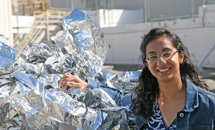
Handy Links
SLAC News Center
SLAC Today
- Subscribe
- Archives: Feb 2006-May 20, 2011
- Archives: May 23, 2011 and later
- Submit Feedback or Story Ideas
- About SLAC Today
SLAC News
Lab News
- Interactions
- Lightsources.org
- ILC NewsLine
- Int'l Science Grid This Week
- Fermilab Today
- Berkeley Lab News
- @brookhaven TODAY
- DOE Pulse
- CERN Courier
- DESY inForm
- US / LHC
SLAC Links
- Emergency
- Safety
- Policy Repository
- Site Entry Form

- Site Maps
- M & O Review
- Computing Status & Calendar
- SLAC Colloquium
- SLACspeak
- SLACspace
- SLAC Logo
- Café Menu
- Flea Market
- Web E-mail
- Marguerite Shuttle
- Discount Commuter Passes
-
Award Reporting Form
- SPIRES
- SciDoc
- Activity Groups
- Library
Stanford
Around the Bay
People Today: Nikita Sunilkumar Takes On the Tides
Over the course of her Student Undergraduate Laboratory Internship at SLAC, University of Southern California engineering student Nikita Sunilkumar has been working on a mystery.
The puzzle started a few years ago, when users at Stanford Synchrotron Radiation Lightsource reported trouble getting the SSRL beam to stay aligned on their samples. While the beam's position relative to its target usually fluctuates within a range of 10 micrometers, something was causing it to become less stable, sometimes moving by as much as 100 micrometers.
As SSRL staff members tried to figure out what was happening, they realized that the problem wasn't coming from the beam's instrumentation, but instead from the foundation of the SPEAR storage ring.
To gauge the fluctuations, researchers looked at data provided by the storage ring's hydrostatic leveling system, or HLS: a series of water-filled tubes that provides real-time information on tiny vertical movements in different parts of the building. Comparing data from the HLS to the outdoor temperature at the site, researchers identified a correlation between temperature and the movement in the building's floor.
The mystery, though, is how the two are connected—which is where Sunilkumar comes in.
"My role has been to analyze the data coming out from SPEAR in terms of temperature fluctuations and all these other systems they have in place to monitor stability, and to basically find the cause for the instability," Sunilkumar said. "Potentially."
So far, there haven't been any solid leads. Because it's a complex system that doesn't readily lend itself to modeling, researchers have had to proceed by trial and error to determine which variables are contributing to the floor's motion. The SSRL roof was painted white last summer in hopes that reflecting sunlight away from the building would stabilize the temperature and, in turn, the beam. In mid July, workers began looking at the asphalt inside the ring as a possible culprit. Sunlight could be warming the asphalt, causing it to expand and putting pressure on the foundation. To reflect this light away, workers covered the asphalt with aluminized Mylar. Last week, researchers took this approach one step further, installing Mylar on the roof and fans inside the SPEAR ring's accelerator tunnel.
To determine whether or not any of these methods has been effective, Sunilkumar has been working with her mentor, SSRL physicist James Safranek, to sift through HLS data from across the previous year. The data analysis is anything but simple. In order to draw accurate conclusions, Sunilkumar has to systematically eliminate noise and systematic errors in the data.
And it turns out that this kind of obfuscation can come from strange places: uniform large-scale movements in the ground underneath the synchrotron ring, changes in ground water levels, even from celestial bodies. Sunilkumar is trying to figure out how to account for tidal effects, which are distorting the data by causing the water inside the HLS system to periodically tilt and shift.
Sunilkumar pulled it all together over the last week, providing researchers with some valuable clues. Painting the roof white last year reduced movement in the beamline by nearly 15 percent. The Mylar, despite having a certain aesthetic appeal, had little effect. The verdict is still out on the fans.
The analysis so far suggests that the floor motion is strongly coupled to temperature variations in the SPEAR ring's tunnel walls. In the coming weeks, researchers will start investigating cracks and joints in the building to identify any additional sources of movement. While it remains uncertain whether the mystery will be solved within the length of her internship, Sunilkumar maintains that the experience has been nothing short of rewarding.
"The kind of work I'm doing is very universal," Sunilkumar said. "It's very basic data analysis, it just happens to be to a very specific problem. I can definitely apply it to a lot of different things. I'm really happy I got this project, it's been a lot of fun."
—Nicholas Bock
SLAC Today, August 5, 2009
